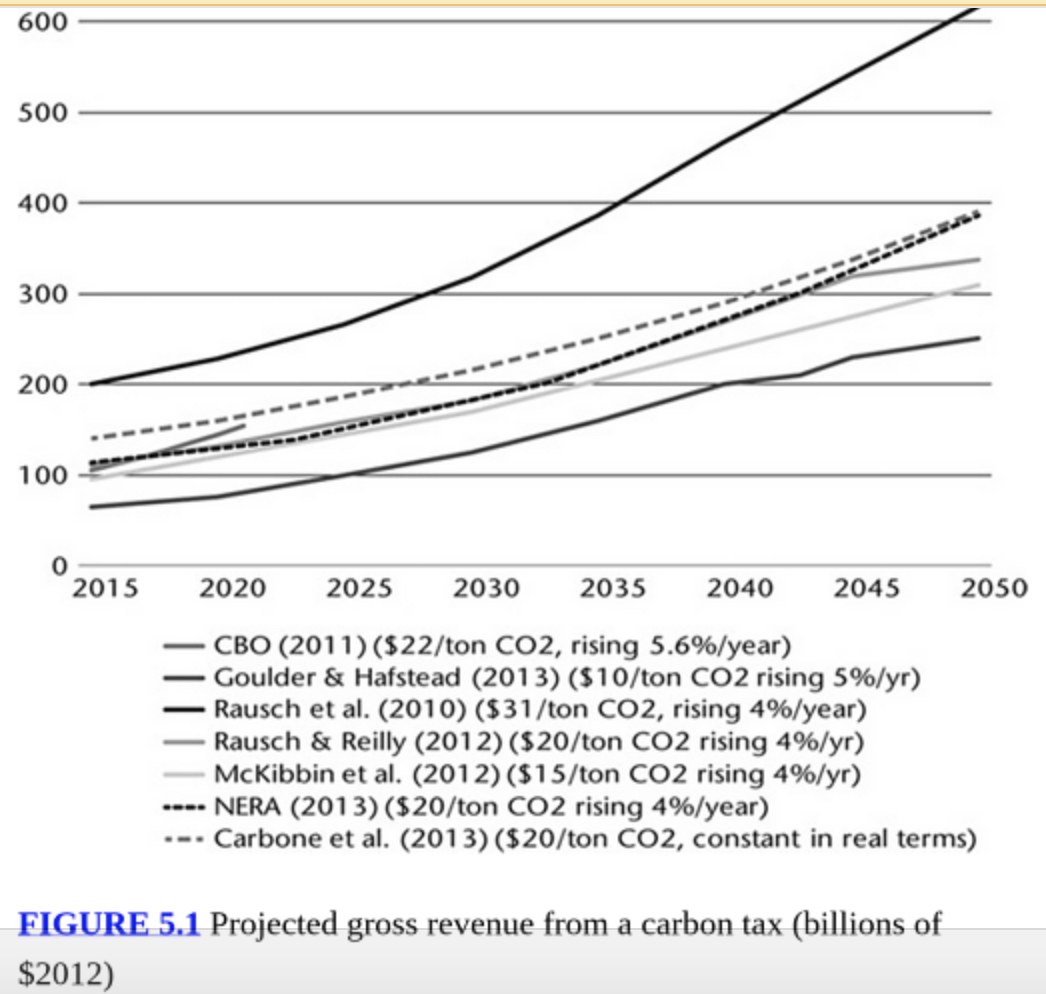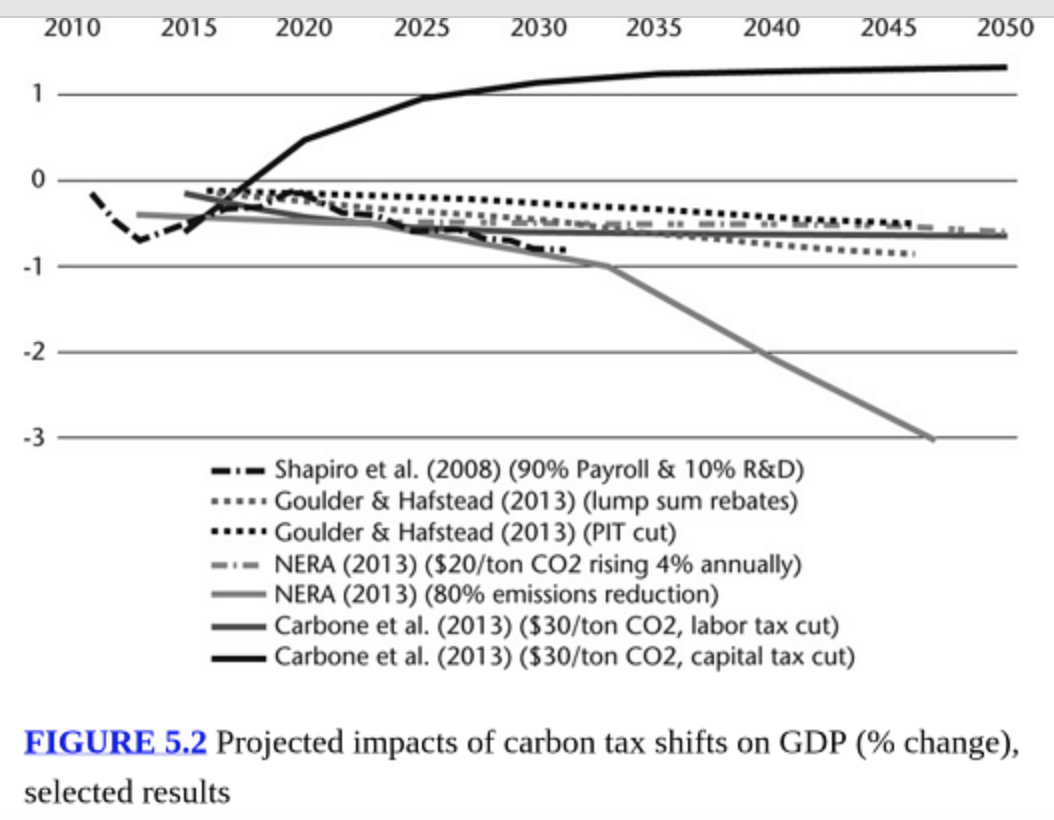Last week, Oren Cass—a senior fellow with the Manhattan Institute—argued in the pages of The Wall Street Journal that recycling carbon tax revenues to provide for tax cuts “does not reduce the cost” of a carbon tax. His argument goes like this: a carbon tax will induce consumers to escape the tax by conserving energy and switching to low carbon fuels. This will lead to a decline in carbon tax revenues which “will trigger irresistible pressure for tax increases.” “As substitute taxes come back online to make up the difference,” Cass maintains, “even if that substitute is simply an ever-increasing rate on the remaining carbon emissions, the economy is left to pay for both the higher-cost energy and the full tax burden it already supports today.” Revenue neutrality will thus prove “a convenient and misleading fiction.”
While the first half of that argument is true (consumers will respond to a carbon tax by reducing carbon consumption: that’s the whole point), the second half of the argument (carbon tax revenues will decline over time) is correct only if carbon tax rates remain relatively flat. Most carbon tax proposals, however, build-in annual rate increases so that the economy can be given time to adjust to the tax (although a strong argument can be made to immediately hit the breaks and impose the optimal carbon tax right now). The tax is intentionally set at a low rate and only gradually increased to reach something approaching best guesses about what the optimal rate might be.
Consider, for instance, seven recently published studies estimating carbon tax revenues over time for various carbon tax proposals, studies summarized in the figure below by economists Roberton Williams III and Casey Wichman in chapter 5 of Implementing a U.S. Carbon Tax: Challenges and Debates:
Each of those modeling runs, by the way, postulate a dynamic economy in which consumers respond to carbon taxes by changing consumption patterns. Admittedly, we can’t be certain about what those revenue curves will look like in the future. They do, however, represent best estimates given current projections about the costs of fuels and energy efficiency investments. If those revenue curves were to instead decline (pace Cass), it would mean that energy efficiency and low carbon fuels will be far, far less expensive than experts presently think.
Is Cass right to fear, however, that steadily increasing carbon tax rates will serve to overwhelm the benefits of the offsetting tax cuts and thus kill prospects for a “free lunch”? Maybe. But free economic meals are neither the point nor the appropriate measure of policy success. We simply want our carbon tax “lunch” to be as inexpensive as possible. As long as it is less expensive than the alternative (in this case, the cost of the risks associated with business-as-usual greenhouse gas emissions and playing dice with the planet), then it is a lunch worth eating.
But rather than speculate, let’s repair to the literature. Consider seven different model runs examining the costs associated with four representative carbon taxes regimes drawn from figure 5.1. Once again, the analysis is provided by Williams & Wichman.
Only one “free lunch” out of these runs is found: the Carbone et al. carbon tax paired with a capital tax cut. When a carbon tax is paired with a labor tax cut, however, Carbone finds that the net economic cost of the carbon tax is reduced by 80 percent. Incidentally, the NERA carbon tax—which is designed to produce an 80 percent emissions reduction—is expensive because is produces a $1,000 per ton carbon tax by 2050 with no offsetting tax cuts. None of the other carbon taxes examined in figure 5.2 postulate more than a $60 per ton carbon tax by 2050.
Figure 5.2 suggests that the macroeconomic impact of a politically viable carbon tax (that is, one south of three figures by 2050), when paired with offsetting tax cuts or rebates of some sort, is small. The revenue neutral carbon taxes examined by Goulder & Hafstead, for instance, would lead to real GDP 20 years hence being 54 percent greater than it is today rather than 55 percent greater. That’s because the impact on consumers would be correspondingly modest. As Williams & Wichman report,
A $20 per ton carbon tax would increase gasoline prices by 18 cents per gallon, but pump prices have varied between $1.60 and $3.60 per gallon; the tax would add about 1.0 cent per kWh to the average price of electricity, but prices have varied between 7.4 and 9.9 cents per kWh; and it would add $0.9 per thousand cubic feet to the price of natural gas, though wellhead prices varied from $2.70 go $8.00 per thousand cubic feet.
It’s a far cry from arguing that the economic costs associated with a carbon tax could well exceed the benefits delivered by the offsetting tax cuts from arguing—as Cass does—that pairing a carbon tax with tax cuts “does not reduce the cost” of a carbon tax.
Cass may be correct that a tax-for-regulation swap will not reduce the overall burden on the economy if the carbon tax seeks more emissions reductions than the present regulatory regime. That will depend, however, on the costs associated with the regulations being displaced (a likely scenario is elimination of the EPA’s “Clean Power Plan”—which regulates existing power plants—EPA regulations for new power plants issued under section 111(b) of the Clean Air Act, plus whatever other green energy regulatory interventions and tax preferences might be thrown out the policy window), how high the carbon tax rate might be, how the revenues from a carbon tax are used, and the specifics of program design.
We know that the Clean Power Plan alone will be tremendously expensive. The best study thus far on the costs of that plan comes out of NERA. They report industry compliance costs of $366 billion to $479 billion over 2017-2031. Consumers will likely spend an additional $560 billion to cut energy consumption. And that’s likely to be only the first of many regulatory initiatives that EPA is preparing to launch to reduce greenhouse gas emissions in other sectors of the economy … price to be determined.
Accordingly, when Cass casually dismisses the regulations that might be jettisoned in a tax-for-regulation swap as “weak and ineffective,” he’s wrong. They are “ineffective” only in the sense that they require major expenditures to achieve modest emission reductions. The Clean Power Plan’s nearly trillion dollars in costs, by one calculation, will produce emission reductions that could be produced by an economy-wide carbon tax of $1.25 per ton rising at $1.25 per year. A study by IHS Energy and Economics for the U.S. Chamber of Commerce, meanwhile, pegs the cost of EPA’s greenhouse gas regulation–addressing both old and new power plants–at $153-$163 per ton of emissions reduced. Marrying corporate income taxes with Goulder & Hafstead’s proposed carbon tax would reduce emissions to a far larger extent at only $29 per ton. Hence, maintaining that carbon taxes “impose costs on the economy very similar to those that accompany cap-and-trade plans or command-and-control regulation” is difficult to swallow.
In sum, Cass’s argument that pairing tax cuts with a tax-for-regulation swap accomplishes no good end is divorced from economic reality. While he’s right to caution against the existence of free lunches, lunches need not be free to be worth having.

